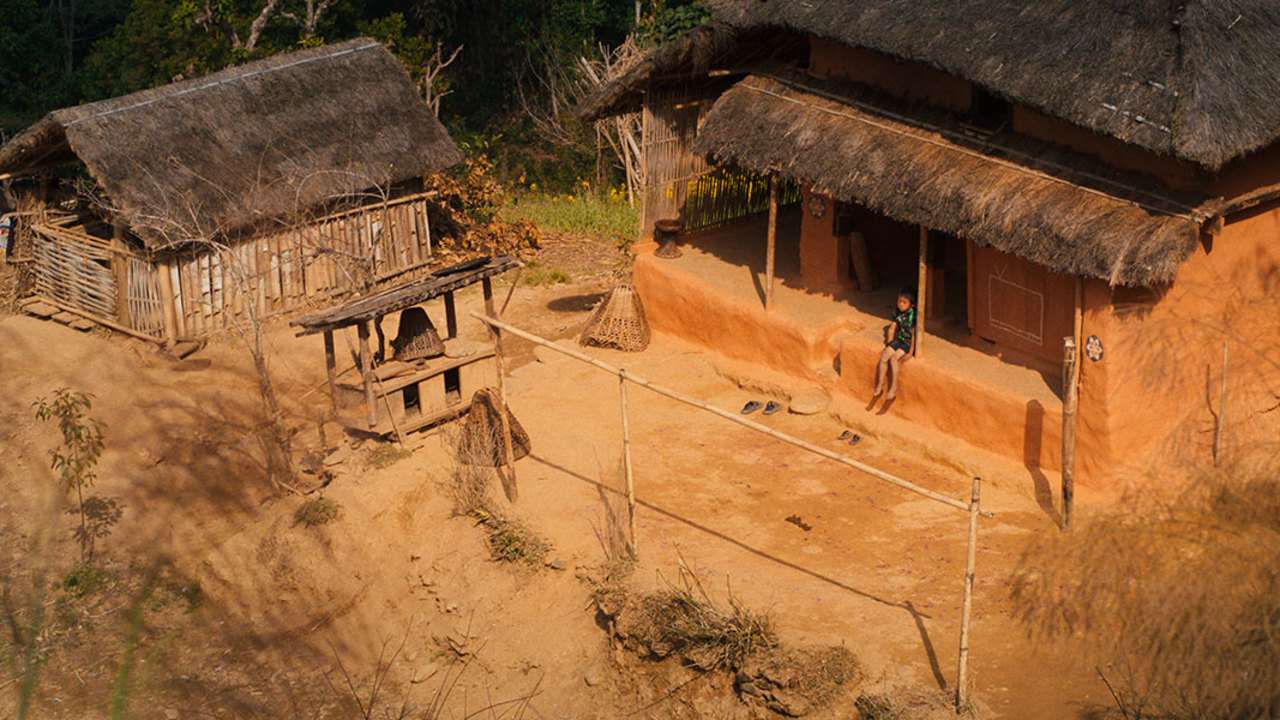In “A Road to a Village” (“Gaun Aayeko Bato”), director Nabin Subba’s characters are located in the existing milieu of the underclass or the working poor who reside in the often-overlooked gap between poverty and development. They have the means to find work but still have to break their backs due to low wages, lack of better opportunities, and other systemic barriers in place. “A Road to a Village” is set in a remote Nepali village up in the hills with the nearest city far from it. Transformation in the shape of a better road and a regular bus service to the city changes the face of the village. So, as progress begins to register an upward shift in the condition of the residents, the film launches a personal and universal inquiry into the tensions between traditions and the forces of global consumerism.
At the heart of the story is a poor Nepali family of three. The patriarch, Maila (Dayahang Rai) earns a living by putting into use his strong weaving skills. However, his handmade bamboo mats and baskets are no longer in demand, as cheaper plastic products now dominate the market. This shift is not merely economic but deeply symbolic of a larger epistemological rupture in the pursuit of a more commodified future. Bindray (Prasana Rai), his seven-year-old son, who earlier used to play with goggles made from plant twigs and leaves, now longs for material ownership that lies far beyond the family’s means to provide. The village now has a TV, and the local shop also sells Coca-Cola and branded beer.
Written by Mahesh Rai and Nabin Subba, “A Road to a Village” explores the personal and broader socio-economic and cultural repercussions of modernization in a village. It also functions as a strong critique of the severe consequences that the working poor have to unwillingly embrace when development is approached without a thorough understanding of its socio-cultural implications. The pressure for change in this Nepali family is tremendous as the demands of the child grow in perspective. To fulfill those, the father, as the provider of the family, makes frequent visits to the city to search for the required financial means to afford their growing needs. There even comes a situation, when the mother, Maili (Pashupati Rai), also considers selling her ancestral jewelry to provide for the family.
The narrative is thus positioned as a battle between the anxieties of survival and the dreams of the family where questions of exploitation, opportunity, and self-respect are given equal grounds. The systemic oppression at play comes out when Maila starts brewing liquor at home to sell in the city, only to be arrested by the police for disregarding the law of the place. But later on, the same police officers green-light the liquor to be transported after a negotiation with Maila’s distributor. The law isn’t an absolute force of justice here, but rather a tool to be selectively applied to the weak.

There’s a well-thought-out scene where Maila discusses the prospects of getting back into the liquor trade. Seated by a pond, he is engaged in a conversation with the man who serves as his distributor and provides him with crucial connections of the trade. But despite the man’s persuasion, Maila is firm in his refusal to re-enter the business. In reply, the distributor reminds him of his reality: if he no longer wishes to weave, and if he is unwilling to get back into the liquor business, then what other means of livelihood remain available to him?
The cycle of exploitation is very apparent here as the question of the lack of alternatives hangs in the air. As Maila sits staring at his reflection in the stillness of the water, the other person splashes a handful of fish food into the pond which shakes up the reflection. The shot serves as a powerful visual reminder of his inner conflict and the destruction of his dream of dignity and his sense of self.
The narrative’s choice to focus on such crucial details not only speaks to the emotional appeal of the plot but also signals a broader socio-cultural shift that is applicable to the entire village community. The film has a devastating end where the poor Nepali family ultimately pays the bigger price for dreaming about the materialist symbols of status and wealth. Director Nabin Subba’s vision is humane and his treatment of this conflict is both empathetic and perceptive. He handles the father’s struggle with remarkable control, allowing for the emotional depth of the situation to stand out despite the layered nature of the narrative. It almost comes as a shock when the father who has always stood by his son—even in his mischiefs, slaps him after being released from jail, when the son asks him about the possibilities of getting their own TV set.
The film’s realistic aesthetic is enriched by the unique beauty of the mountainous regions at the foothills of the Himalayas. It captures the serene stillness of the village’s natural surroundings while juxtaposing it with the growing unease and tension palpable among its inhabitants. A signboard of branded beer hangs on the top of a modest village shop. There’s a dish antenna, a very modern equipment, in the home of one of Brinday’s friends, yet the home remains an old-fashioned village hut. It reflects both the unspoken desires of its people and the inescapable forces of change that it cannot resist. Cinematographer Josh Herum’s work deserves appreciation here.
The characterization of Maila and Brinday forms the narrative’s emotional core, which is why the ending feels so haunting. Maila is shown to be a provider who is now losing out. He grapples with an existential void, constantly reminded that he is now “of no use to anyone.” His actions reflect a complex blend of pride, desperation, and quiet resignation. Meanwhile, Brinday serves as the other part of the film’s core.
His innocence speaks more than his words. The relationships that he shares with his friends are charming and endearingly funny – particularly the way he takes control of the boy gang with a bottle of Coca-Cola that legitimizes his authority. Both Dayahang Rai and Prasana Rai bring their characters to justice. By interrogating the mechanisms of modernization that often overlook the human cost of progress, “A Road to a Village” is not only emotionally powerful but also demonstrates the intellectual depth to engage audiences with global concerns about cultures and identities at risk.



![Lina From Lima (Lina de Lima) [2019]: ‘TIFF’ Review – A Mother’s World of Hurt](https://79468c92.delivery.rocketcdn.me/wp-content/uploads/2019/09/Lina-From-Lima-Lina-de-Lima-higonfilms-768x384.jpg)
![Still Out of My League [2021] Review: A well-intentioned, yet mediocre Rom-com](https://79468c92.delivery.rocketcdn.me/wp-content/uploads/2021/12/Still-Out-of-My-League-2021-768x432.jpg)
![Serpico [1973] – A Paradox Known as ‘Honest Cop’](https://79468c92.delivery.rocketcdn.me/wp-content/uploads/2016/06/Serpico-3-768x511.jpg)
